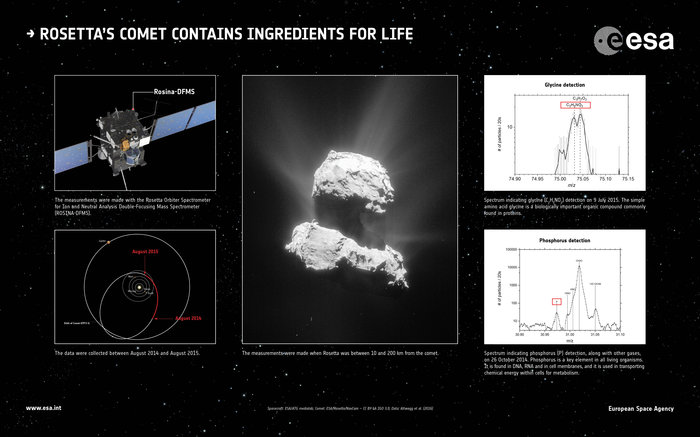Organic molecules crucial for life found in Rosetta’s comet

Scientists analyzing data acquired by ESA's comet chaser Rosetta while orbiting comet 67P/Churyumov–Gerasimenko have discovered organic molecules regarded as crucial for the origin of life on Earth. The ingredients include the amino acid glycine (C2H5NO2), commonly found in proteins, and phosphorus (P), a key element in all living organisms, found in the backbone of DNA and RNA, in cell membranes, and in adenosine triphosphate (ATP), which transports chemical energy within cells for metabolism.
The measurements were made before the comet reached its closest point to the Sun – perihelion – in August 2015 in its 6.5-year orbit.
The first detection was made in October 2014 while Rosetta was just 10 km (6.2 miles) from the comet. The next occasion was during a flyby in March 2015, when it was 30 – 15 km (18.6 – 9.3 miles) from the nucleus.
Glycine was also seen on other occasions associated with outbursts from the comet in the month leading up to perihelion when Rosetta was more than 200 km (124 miles) from the nucleus but surrounded by a lot of dust.
“This is the first unambiguous detection of glycine at a comet,” says Kathrin Altwegg, principal investigator of the ROSINA instrument that made the measurements, and lead author of the new paper published in Science Advances last week.
“At the same time, we also detected certain other organic molecules that can be precursors to glycine, hinting at the possible ways in which it may have formed.”
“We see a strong link between glycine and dust, suggesting that it is probably released perhaps with other volatiles from the icy mantles of the dust grains once they have warmed up in the coma,” says Kathrin.
Glycine turns into gas only when it reaches temperatures just below 150°C (302 °F), meaning that usually little is released from the comet’s surface or subsurface because of the low temperatures. This accounts for the fact that Rosetta does not always detect it.
“Glycine is the only amino acid that is known to be able to form without liquid water, and the fact we see it with the precursor molecules and dust suggests it is formed within interstellar icy dust grains or by the ultraviolet irradiation of ice, before becoming bound up and conserved in the comet for billions of years,” adds Kathrin.
Another exciting detection made by Rosetta and described in the paper is of phosphorus, a key element in all known living organisms. For example, it is found in the structural framework of DNA and cell membranes, and it is used in transporting chemical energy within cells for metabolism.

Credit: Spacecraft: ESA/ATG medialab; Comet: ESA/Rosetta/NavCam – CC BY-SA IGO 3.0; data: Altwegg et al. (2016)
Co-author Hervé Cottin said there is still a lot of uncertainty regarding the chemistry on early Earth, and there is, of course, a huge evolutionary gap to fill between the delivery of these ingredients via cometary impacts and life taking hold, but the important point is that comets have not really changed in 4.5 billion years: they grant us direct access to some of the ingredients that likely ended up in the prebiotic soup that eventually resulted in the origin of life on Earth.
“The multitude of organic molecules already identified by Rosetta, now joined by the exciting confirmation of fundamental ingredients like glycine and phosphorous, confirms our idea that comets have the potential to deliver key molecules for prebiotic chemistry,” says Matt Taylor, ESA’s Rosetta project scientist.
Series of images of Comet 67P/Churyumov–Gerasimenko captured by Rosetta’s OSIRIS narrow-angle camera on July 26, 2015 from a distance of about 170 km (105 miles). Copyright: ESA/Rosetta/MPS for OSIRIS Team MPS/UPD/LAM/IAA/SSO/INTA/UPM/DASP/IDA
“Demonstrating that comets are reservoirs of primitive material in the Solar System and vessels that could have transported these vital ingredients to Earth, is one of the key goals of the Rosetta mission, and we are delighted with this result,” Taylor concluded.
Reference:
- “Prebiotic chemicals – amino acid and phosphorus – in the coma of comet 67P/Churyumov–Gerasimenko” – K. Altwegg et al – Science Advances – May 27, 2016: Vol. 2, no. 5, e1600285 DOI: 10.1126/sciadv.1600285
- "Rosetta's comet contains ingredients for life" – an article published by ESA on May 27, 2016
Featured image copyright: ESA/Rosetta/NavCam – CC BY-SA IGO 3.0

Commenting rules and guidelines
We value the thoughts and opinions of our readers and welcome healthy discussions on our website. In order to maintain a respectful and positive community, we ask that all commenters follow these rules.